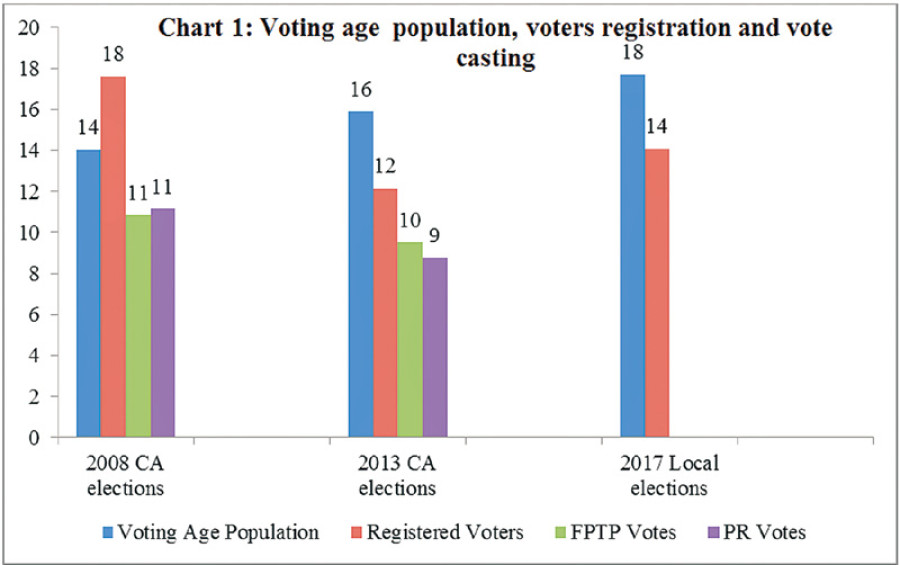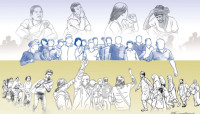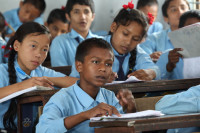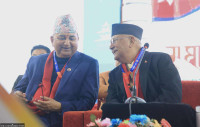Opinion
Lies, damn lies and statistical lies
There is a popular saying in statistics that there are three types of lies—lies, damn lies and statistical lies.
There is a popular saying in statistics that there are three types of lies—lies, damn lies and statistical lies. As we enter a post-truth era, this differentiation will probably cease to exist because lies will dominate the world. Writing for aljazeera.com, Mr Ahmed Al Sheikh describes a post-truth era as one where lies replace the truth, emotions replace honesty, personal analysis replaces verified information and single opinion replaces multiple opinions. And this statement aptly fits our data on voters, voting and voting age population.
Voter discrepancies
Before the second CA elections in 2013, I wrote in these pages that the elections would be technically flawed (‘Down came the king’, July 16, 2013). The reason was that a large swath of voters—3 to 5 million—was missing from the electoral roll. In 2013, the election commission came out with a figure of 12 million voters. Based on the population census of 2011, we had a voting age population (18 years and above) of 15 million. In the 2008 CA elections, there were nearly 18 million voters and of these 11 million exercised their voting rights. Therefore, compared to 11 million voters who cast their votes in 2008, a considerably lower figure of 12 million voters registered in 2013. If this trend is anything to go by, the upcoming election is not going to represent the will of the people and could be a sham.
The election commission has now published a figure of 14 million registered voters for the upcoming local elections. This indicates an increase of 2 million voters over the span of four years—between the 2013 CA elections and now. Based on the latest census (2011) and the population projection of the Central Bureau of Statistics (CBS), the voting-age population is close to 18 million. This difference of four million voters presents a substantial figure, with more than one-fifth of the voting age population missing from the voting process.

The entire eligible voting-age population, as disclosed by the population census, may not even register their names on the voting list. If the basic purpose of electoral democracy is to measure the popular will of the people, the voter registration data should be closer to the voting-age population, or adequate explanations should be provided regarding the discrepancy.
Based on the huge discrepancy between registered voters in the CA elections of 2008 and 2013, I concluded that the elections in 2013 were technically flawed. From the available data, we can conclude that either the number of voters was substantially inflated in 2008, indicating that the first CA elections were rigged, or there was under-registration of voters in 2013, or a combination of the two. The voters’ number might have been inflated in 2008 as there are more registered voters than the voting age population. But whether the elections were rigged is doubtful, as even the former rebels were surprised by the election outcome. There is also the credibility of international observers.
In 2013, amid the election boycott by the Mohan Baidya faction of the Maoists, the Khil Raj Regmi government and the political parties were determined to fill the political vacuum created by the dissolution of the CA. The key players were more focused on concluding the elections, rather than reviewing the election system in general. In 2013, an explanation was offered for the reduction in voters’ registration; it was said that it was a result of foreign employment. This is an absurd explanation as the data on foreign employment is a cumulative figure spanning more than a decade. Moreover, we only have data on out-going migrant workers, not returnees.
Aggravating the problems
Before the 2008 elections, over 4 million citizenship certificates were distributed in the wake of the Madhesi movement of 2007, and in 2013, ID cards were introduced. This might have inflated or curtailed voters’ registration. One can see from the table that there is not much difference between the votes cast in the 2008 and in the 2013 CA elections. This applies both for the direct (FPTP) and proportional representation (PR) voting systems.
When elections do not reflect the will of the people, they could become a problem in themselves. Could it be because of inflated voters and possible rigging in 2008 that the first CA failed to draft a constitution? By the same reasoning, is it because of missing voters in 2013 that we are facing the current political crisis? Remember that in 2008, we took some important decisions and declared the country to be a federal, secular republic based on the CA results. If the CA results are based on flawed data, how do we respond to the monarchists if they claim the CA’s decisions do not represent the popular will of the people?
There are multiple national and international agencies and donors who are spending millions of dollars in supporting and monitoring Nepal’s electoral democracy. However, I have never come across an agency that tries to explain the huge discrepancy between the voting age population and the data on registered voters. In the absence of proper explanations regarding the figures on missing voters or the difference between the voting age population and the number of registered voters, the proposed local elections may meet the same fate as the CA elections in 2013. And we may not be able to solve our political problems. In fact, given the controversy surrounding the local level elections, we might be aggravating the problems.
- Manandhar is a freelance consultant




 10.12°C Kathmandu
10.12°C Kathmandu









